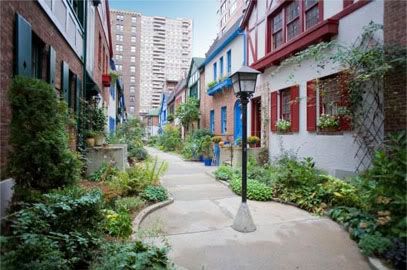 |
I meant to post this image a while ago, and I can't remember now where I found it, but there is a tiny section of New York City which looks like some village in England called the Pomander Walk.
Here's what Wikipedia says about this small strip:
The "[Pomander] Walk" itself, consisting of two rows of eight buildings facing each other across a narrow courtyard, runs through the middle of the block between 94th and 95th, with a gate at each end. Each building originally had one flat on each floor. In recent years, some buildings have been reconfigured to serve as duplexes and single-family homes.The article describes Pomander Walk as "Tudoresque." Here is another, surprising, section of New York called Tudor City, which is more Tudoresque than these rows of tiny cottages. Rather than cottage-like row houses, Tudor City is an impressive collection of highrises. Here's some information:
Pomander Walk was built in 1921 by nightclub impresario Thomas J. Healy who planned to build a major hotel on the site. According to city historian Christopher Gray, when Healy was unable to get financing for a hotel, he built the houses that stand on the site today, apparently to provide a temporary cash-flow while he waited to raze them and build the hotel. It was designed by the New York architecture firm King and Campbell.
In 2009 the owners completed a four-year facade renovation, restoring architectural details that had been lost for decades. In 2008 Landmark West! bestowed their Building Rehabilitation Award on Pomander Walk.
The complex is named for Pomander Walk, a romantic comedy by Louis N. Parker that opened in New York in 1910. The play is set on an imaginary byway near London. The place as built bears scant resemblance to the setting described in the play as "a retired crescent of five very small, old-fashioned houses near Chiswick, on the river-bank. ... They are exactly alike: miniature copies of Queen Anne mansions". New York City's Pomander Walk is Tudoresque, a style that enjoyed a vogue in America in the years following World War I.
In 1925 Fred F French - also known for the Fred F. French Building and Knickerbocker village - started construction of what he called 'The largest project in Midtown'. The project was named Tudor City.I've been in Tudor City, both in the neighborhood and in one of the apartments. Residents (and owners) have tiny apartment complexes which I'm sure cost quite a bit. It seems that "old" things come to New York in tiny sizes. Perhaps old is not the New York (or the American) way. Instead, I think it is: the newer, the bigger, and the better.
Completed in 1928, it consisted of 12 apartment buildings containing 3000 housing units and 600 hotel rooms. The design by the architect H. Douglas Ives and his team was based heavily on the Tudor Style, an architectural style prevalent during the Tudor Dynasty. Characteristic for this style is the brickwork and the application of fine intricate stonework.